
Hello darkness, my old friend. Cuban Coffee, you’re always there to pick me up. Thank you for helping me through college, 12 hour shifts, and motherhood. To show my appreciation, I’m telling the world about you. I believe that all people should be able to reap the benefits of your warmth, sweetness, and spunk.
Café Cubano, affectionately known as cafécito, is the lifeblood of the Cuban culture. Living in South Florida, it is very much a part of our daily life. Not only does it serve as a morning (or afternoon) boost, it also helps bring people together. It has become somewhat of a social catalyst in this area, taking the place of the ever-popular water cooler gathering.

I work in a busy NICU where Cuban Coffee is made twice daily (mid-morning and mid-afternoon). We have a few Cuban Coffee connoisseurs, who take the lead in making it. When done brewing, the self-proclaimed NICU barista places phone calls, in hidden code form, to let people know that “it’s ready”. We all know what “it” is. If you have to ask, you are not cool. Since it’s very strong, it’s served in little plastic medicine cups (the irony in that is very fitting) and then rationed out to weary doctors, nurses, and therapists. Then, suddenly, as with the wave of a magic wand, all is good with the world again.

Cuban Coffee is basically espresso that has been sweetened with a thick paste made from sugar and the first few teaspoons of espresso that drip out of the coffee maker. That first bit of coffee is the strongest and most ideal for making this sweet, foamy layer or espuma that sits on top of a freshly made cup. This layer of creamy goodness is what sets Cuban Coffee apart from other espressos and is also a sign of a well-made, authentic cafécito.
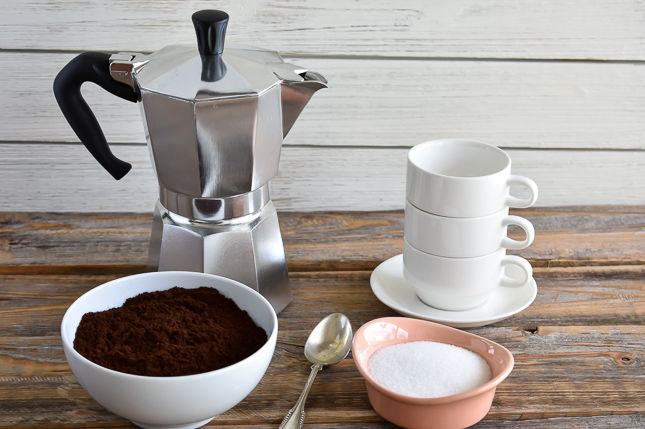
Making Cuban Coffee is simple, but there are some essentials you need, as well as an easy lesson on how to achieve that sought-after foamy top layer. Indispensable ingredients and equipment include Cuban coffee, sugar, and an espresso pot/machine.
Cuban coffee, like Italian espresso, is made from finely ground, dark-roasted coffee. It is brewed in either a stovetop espresso maker, known as a Moka pot, or in an electric espresso machine. I have this Moka pot, which brews enough for six demitasse (2 ounce) servings.
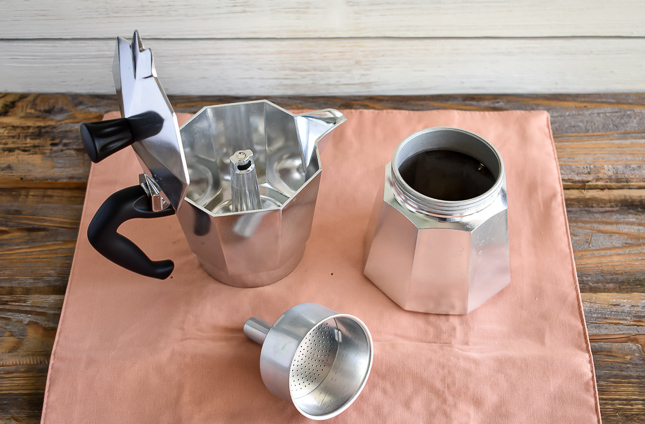
The stovetop Moka pot, or cafetera, was created in Italy by Alfonso Bialetti in 1933. It consists of three parts: a boiler at the bottom where the water is placed, a funnel-shaped filter where the coffee grounds go, and an upper compartment where the brewed coffee collects.
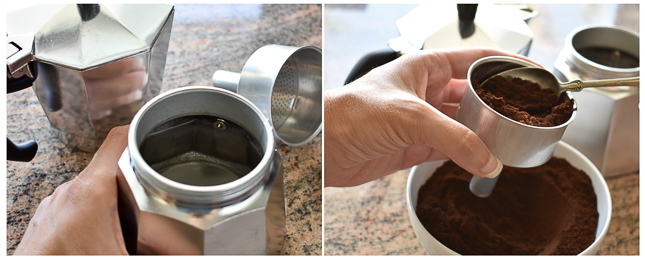
It works by means of a pressurized system that pushes water from the bottom chamber to the top of the pot. As water heats in the bottom compartment, it creates steam and pressure. This causes it to be pushed up through the coffee-filled funnel to the upper part of the Moka pot where the brewed espresso drips out. Then, the fun begins.
As you wait for the coffee to brew (which takes just under 10 minutes), place your sugar into a container with a spout. I use a glass measuring cup. Adjust the amount of sugar depending on your preference and the amount of coffee you’re making. I use one level tablespoon per serving of espresso, which is six tablespoons for the size of my coffee maker. I know that’s a lot. My sweet tooth always wins. Feel free to use less. You can also use light brown sugar in place of granulated white sugar.
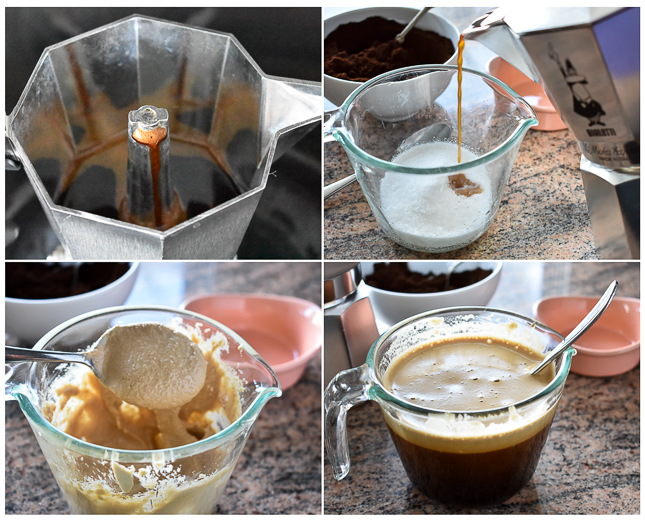
As soon as the espresso begins to drip out, a very small amount of it (I start with about one tablespoon, but I don’t really measure) is poured into the sugar. Then, it is mixed vigorously (if you’re doing it right, your arm will hurt) until a thick light brown paste is formed. It should be close to the consistency of creamy peanut butter.
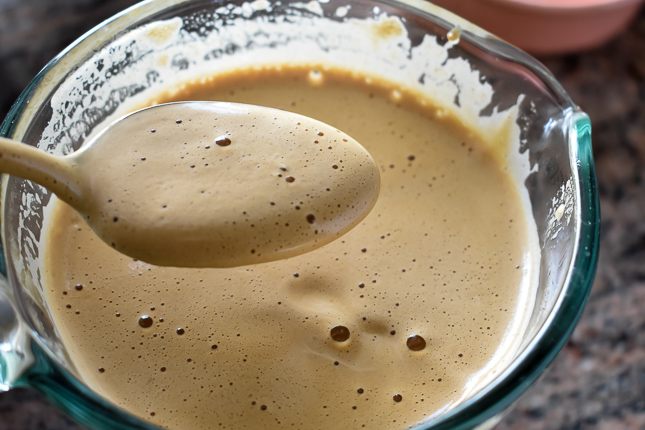
Once the rest of the espresso has finished brewing, it’s poured into the cup with the sugar paste mixture and then gently stirred until the sugar dissolves. There will be a thick, foamy layer on top. As you pour it into individual demitasse cups, make sure each cup gets some of that sweet, delicious espuma. Spoon some on if you need to.

Bonus coffee drinks! You can make other delicious types of coffee with this same Cuban Coffee recipe, such as the popular cortado or cortadito (cortar means “to cut”), in which milk is added or “cut” into the coffee. The ratio is usually 50/50 milk and Cuban coffee. This is a great alternative for those who prefer a lighter option.
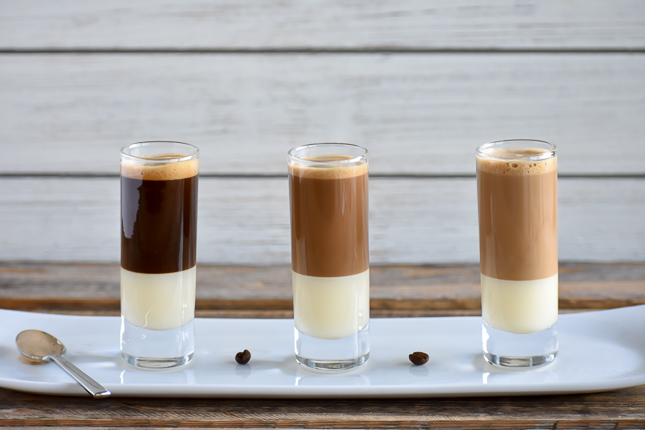
Another insanely delicious (and my personal favorite) option is to make a cortadito leche y leche, which is basically a cortadito sweetened with condensed milk. This variation is popular in the Canary Islands, Spain. It’s where I first had one and I haven’t stopped thinking about it since. If you plan on making one, just be sure to use less sugar in your Cuban coffee to offset the sweetness of the condensed milk.

Then there’s the ever-popular, café con leche, my go-to coffee every morning. It’s a Spanish-speaking latte without the steamed milk on top. It’s sweet, rich, and smooth.

Cuban Coffee, with its dark, sweet, velvety flavor, has been gaining popularity all over the world and has won over the tired hearts of millions. If you want to see what the fuss is all about, make yourself a cafécito. Que rico!
You might also like:
Slow Cooker Cuban Black Beans – Frijoles Negros
Cuban Coffee
Cuban coffee is rich, dark, and sweet with a distinctive and delicious foamy layer on top. Easy to make if you follow these simple steps.
- **My Moka pot makes 6 demitasse (2 ounce) servings. Adjust sugar according to number of servings and sweetness desired**
- water
- Cuban coffee ( other espresso may be substituted)
- 1/2 – 1 level Tablespoon per demitasse serving granulated sugar (adjust to desired sweetness)
-
Fill Moka pot’s lower chamber with water to bottom of safety valve
-
Add Cuban coffee to filter, pressing down gently. Do not pack down tightly. Place filter into bottom chamber and fasten upper compartment into place.
-
Place on stove top over medium heat being careful not to place pot handle over heat source. Leave the Moka pot lid open.
-
Place the sugar into a measuring cup.
-
As soon as the first bit of coffee starts brewing out, pour about one Tablespoon or so (less if using less sugar) to the measuring cup with the sugar (adding more if needed). Place pot back on stove top to continue brewing. Immediately stir sugar/coffee mixture vigorously with a spoon until a thick paste is made.
-
Once the coffee is done brewing, pour it into the measuring cup with the sugar paste. Stir it gently until sugar is dissolved. Serve into demitasse espresso cups.
An electric espresso machine works well in place of a Moka pot. Just adjust the amount of sugar depending on number of servings.
Cuban coffee is my dear friend. Love this post its so simply layer out. Brilliant!
Thank you 🙂 I’m happy you enjoyed reading it.
I made this Cuban coffee with breakfast this morning and aside from the caffeine waking me up, the taste was phenomenal! I used a coffee maker with the espresso attachment and it came out great, very easy! It made the espuma perfectly despite not having the real-deal Cuban cafetera. I will be making this more!
I love this Cuban coffee. What is your ratio for expresso to milk for the cafe con leche?
Hi Tracey. I love it too! I like my cafe con leche on the light side, so I usually will do about 2 parts 2% lowfat or whole milk to 1 part Cuban coffee. Enjoy!
What’s your favorite brand of ground coffee for a cafecito? I’ve tried Bustelo, La Llave, Pilon, Gavina,, Medaglia D’Oro…should I try La Carreta?
Hello! I usually have Bustelo at home, but I have tried others with great results too 😉
It tastes pretty good. I did about 3.5 Tbsp. of brown sugar, which was still a little too sweet for us.
The disappointing part was that I didn’t have any foam after vigorously stirring. Next time I will add less coffee to the sugar and hope that does it.
Still a yummy drink though! It’s always fun to get new ideas of how to make coffee with our moka pots. 🙂
Excellent way of telling, and nice afticle to take facts regarding my
presentation focus, which i am going to convey in academy.
My webb blog: Casinoslotprinciples.Blogspot.Com
Lirigzon Gashi
I couldn’t resist commenting. Well written!
My web-site: Sites.Google.Com
I almost never leave responses, but after reading a bunch of comments here Cuban Coffee.
I do have 2 questions for you if you tend not too mind.
Couod it be just mme or do a few of these comments look as
if they are written byy brain dead people? 😛 And, if you are posting at other sites, I’d like
to keep up with you. Wuld you list of every one of all your social community pages
like your linledin profile, Facebook page or twitter feed?
My page :: Ross
hn2p04
Greet to My Avtoblog https://avtoblog2024.blogspot.com/ — your trusted outset for up-to-date intelligence from the automotive world. We are committed to portion auto enthusiasts past providing blue blood articles, the latest rumour, additional make reviews, and tips on how to take meticulousness of your car. Whether you’re a advanced driver or an on the ball buggy lover, our blog is designed to servants you pilot the automotive industry.
We refuge noted topics such as choosing the honourable car, safe and sound driving tips, continuation and servicing recommendations. Our masterly reviews thinks fitting eschew you more intelligent interpret the pros and cons of contemporary models, so you can move an cultivated arbitration when purchasing.
In uniting, at My Avtoblog, you will discover preoccupation hacks to serve you put by on auto maintenance and operation. We also offer tidings on hip automotive technologies that certify driving more insouciant and safe.
Unite our community of auto enthusiasts, know fruitful tips, and stay up-to-date with the latest events in the automotive happy with My Avtoblog!